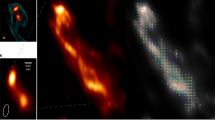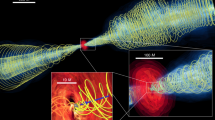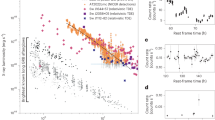Abstract
Observational constraints of the relativistic jets from black holes have largely come from the most powerful and extended jets1,2, leaving the nature of the low-luminosity jets a mystery3. M81∗ is one of the nearest low-luminosity jets and it emitted an extremely large radio flare in 2011, allowing us to study compact core emission with unprecedented sensitivity and linear resolution. Using a multiwavelength campaign, we were able to track the flare as it re-brightened and became optically thick. Simultaneous X-ray observations indicated that the radio re-brightening was preceded by a low-energy X-ray flare at least 12 days earlier. Associating the time delay (tdelay) between the two bands with the cooling time in a synchrotron flare4,5, we find that the magnetic field strength was 1.9 < B < 9.2 G, which is consistent with magnetic field estimate from spectral energy distribution modelling6, B < 10.2 G. In addition, Very Long Baseline Array observations at 23 GHz clearly illustrate a discrete knot moving at a low relativistic speed of vapp/c = 0.51 ± 0.17 associated with the initial radio flare. The observations indicate radial jet motions for the first time in M81∗. This has profound implications for jet production, as it means radial motion can be observed in even the lowest-luminosity AGN, but at slower velocities and smaller radial extents (≍104 RG).
This is a preview of subscription content, access via your institution
Access options
Subscribe to this journal
Receive 12 print issues and online access
$259.00 per year
only $21.58 per issue
Buy this article
- Purchase on SpringerLink
- Instant access to full article PDF
Prices may be subject to local taxes which are calculated during checkout






Similar content being viewed by others
References
Jorstad, S. G. et al. Polarimetric observations of 15 active galactic nuclei at high frequencies: jet kinematics from bimonthly monitoring with the very long baseline array. Astron. J. 130, 1418–1465 (2005).
Asada, K., Nakamura, M., Doi, A., Nagai, H. & Inoue, M. Discovery of sub- to superluminal motions in the M87 jet: an implication of acceleration from sub-relativistic to relativistic speeds. Astrophys. J. 781, L2 (2014).
Falcke, H., Körding, E. & Nagar, N. M. Compact radio cores: from the first black holes to the last. New Astron. Rev. 48, 1157–1171 (2004).
Urry, C. M. et al. Multiwavelength monitoring of the bl lacertae object PKS 2155-304 in 1994 May. III. Probing the inner jet through multiwavelength correlations. Astrophys. J. 486, 799–809 (1997).
Bai, J. M. & Lee, M. G. Radio/X-ray offsets of large-scale jets caused by synchrotron time lags. Astrophys. J. 585, L113–L116 (2003).
Kellermann, K. I. & Pauliny-Toth, I. I. K. Compact radio sources. Annu. Rev. Astron. Astrophys. 19, 373–410 (1981).
Bartel, N., Bietenholz, M. F., Rupen, M. P. & Dwarkadas, V. V. SN 1993J VLBI. IV. A geometric distance to M81 with the expanding shock front method. Astrophys. J. 668, 924–940 (2007).
Devereux, N., Ford, H., Tsvetanov, Z. & Jacoby, G. STIS spectroscopy of the central 10 parsecs of M81: evidence for a massive black hole. Astron. J. 125, 1226–1235 (2003).
de Bruyn, A. G., Crane, P. C., Price, R. M. & Carlson, J. B. The radio sources in the nuclei of NGC 3031 and NGC 4594. Astron. Astrophys. 46, 243–251 (1976).
Bartel, N. et al. The nucleus of M81—simultaneous 2.3 and 8.3 GHz mark III VLBI observations. Astrophys. J. 262, 556–563 (1982).
Bietenholz, M. F., Bartel, N. & Rupen, M. P. The location of the core in M81. Astrophys. J. 615, 173–180 (2004).
Martí-Vidal, I. et al. Detection of jet precession in the active nucleus of M81. Astron. Astrophys. 533, A111 (2011).
Ishisaki, Y. et al. X-ray properties of the nucleus of M81. Publ. Astron. Soc. Jpn 48, 237–248 (1996).
Merloni, A., Heinz, S. & di Matteo, T. A fundamental plane of black hole activity. Mon. Not. R. Astron. Soc. 345, 1057–1076 (2003).
Markoff, S. et al. Results from an extensive simultaneous broadband campaign on the underluminous active nucleus M81∗: further evidence for mass-scaling accretion in black holes. Astrophys. J. 681, 905–924 (2008).
Miller, J. M., Nowak, M., Markoff, S., Rupen, M. P. & Maitra, D. Exploring accretion and disk-jet connections in the LLAGN M81∗. Astrophys. J. 720, 1033–1037 (2010).
Ho, L. C., van Dyk, S. D., Pooley, G. G., Sramek, R. A. & Weiler, K. W. Discovery of radio outbursts in the active nucleus of M81. Astron. J. 118, 843–852 (1999).
Pooley, G. Radio flare in M81. Astron. Telegr. 3621, 1 (2011).
Cotton, W. D. et al. The very flat radio spectrum of 0735 plus 178—a cosmic conspiracy. Astrophys. J. 238, L123–L128 (1980).
Merloni, A. & Fabian, A. C. Coronal outflow dominated accretion discs: a new possibility for low-luminosity black holes? Mon. Not. R. Astron. Soc. 332, 165–175 (2002).
Markoff, S., Nowak, M. A. & Wilms, J. Going with the flow: can the base of jets subsume the role of compact accretion disk coronae? Astrophys. J. 635, 1203–1216 (2005).
Merloni, A. & Heinz, S. Measuring the kinetic power of active galactic nuclei in the radio mode. Mon. Not. R. Astron. Soc. 381, 589–601 (2007).
Gallo, E. et al. A dark jet dominates the power output of the stellar black hole cygnus X-1. Nature 436, 819–821 (2005).
Bietenholz, M. F. et al. VLBI observations of the ultracompact radio nucleus of the galaxy M81. Astrophys. J. 457, 604–609 (1996).
Bietenholz, M. F., Bartel, N. & Rupen, M. P. A stationary core with a one-sided jet in the center of M81. Astrophys. J. 532, 895–908 (2000).
Chatterjee, R. et al. Disk-jet connection in the radio galaxy 3C 120. Astrophys. J. 704, 1689–1703 (2009).
Chatterjee, R. et al. Connection between the accretion disk and jet in the radio galaxy 3C 111. Astrophys. J. 734, 43–59 (2011).
Wehrle, A. E. et al. Kinematics of the parsec-scale relativistic jet in quasar 3C 279: 1991–1997. Astrophys. J. Suppl. 133, 297–320 (2001).
Acknowledgements
A.L.K. acknowledges support provided by NASA through an Einstein Postdoctoral Fellowship (grant number PF4-150125) awarded by the Chandra X-ray Center, which is operated by the Smithsonian Astrophysical Observatory for NASA under contract NAS8-03060.
Author information
Authors and Affiliations
Contributions
A.L.K. led the data reduction and analysis, with contributions from J.M.M., M.B. and A.M. K.G., M.T.R., M.R. and N.B. contributed to discussion and interpretation.
Corresponding author
Ethics declarations
Competing interests
The authors declare no competing financial interests.
Supplementary information
Supplementary information
Supplementary information (PDF 766 kb)
Rights and permissions
About this article
Cite this article
King, A., Miller, J., Bietenholz, M. et al. Discrete knot ejection from the jet in a nearby low-luminosity active galactic nucleus, M81∗. Nature Phys 12, 772–777 (2016). https://doi.org/10.1038/nphys3724
Received:
Accepted:
Published:
Issue date:
DOI: https://doi.org/10.1038/nphys3724
This article is cited by
-
An energetic hot wind from the low-luminosity active galactic nucleus M81*
Nature Astronomy (2021)
-
Delayed radio flares from a tidal disruption event
Nature Astronomy (2021)
-
Substructures in Simulations of Relativistic Jet Formation
Brazilian Journal of Physics (2017)
-
More similar than knot
Nature Physics (2016)



